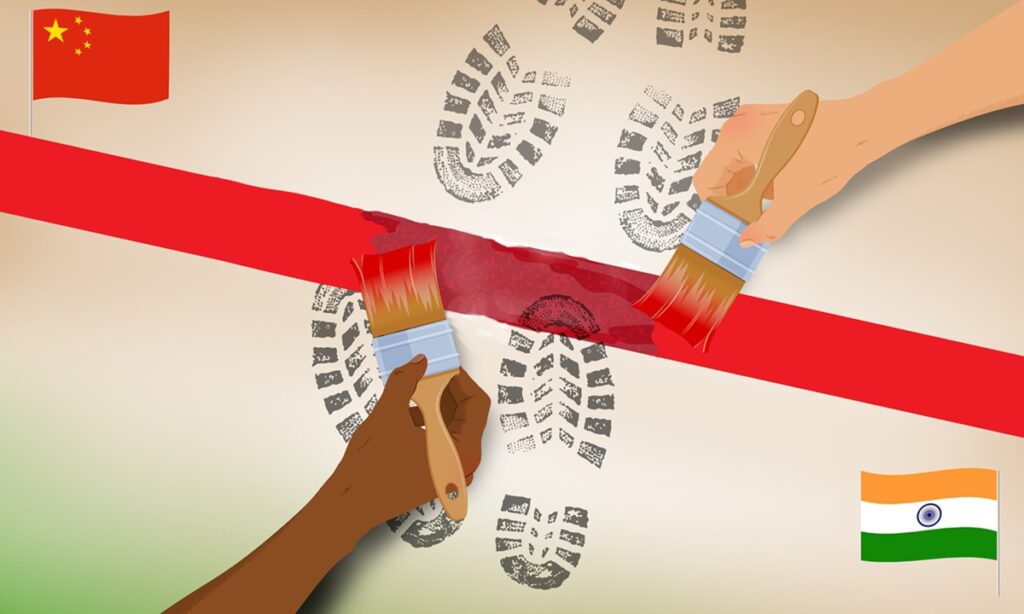Amid China and India’s joint efforts to promote the cooling of border tension since the outbreak of the 2020 Galwan Valley border clash, Thursday witnessed a positive development. The Chinese and Indian troops in the area of Jianan Daban have begun to disengage in a coordinated and planned way, according to the consensus reached in the 16th Round of China-India Corps Commander Level Meeting held in July, China’s Ministry of National Defense said in a statement on Friday.
Before this meeting, little breakthroughs on disengagement were made in the previous few rounds of corps commander level talks, observer noted. Last time, the major process was made in February 2021, when Chinese and Indian frontline troops at the south and north bank of the Pangong Tso Lake began a synchronized and organized disengagement, based on the consensus reached in the ninth round of the China-India Corps Commander Level Meeting in January. The latest disengagement is a step forward.
The disengagement of the front-line troops in Jianan Daban shows that the Chinese side has created conditions for further improvement of China-India ties while safeguarding territorial sovereignty. It is a positive trend that mirrors the easing tensions over the border areas since the Galwan Valley conflict, Lin Minwang, a professor at the Institute of International Studies of Fudan University, told the Global Times.
It will create a positive atmosphere to comprehensively resolve the standoff in the western sector of border areas, and will play a role in restoring and enhancing mutual trust between the two militaries, said Qian Feng, director of the research department at the National Strategy Institute at Tsinghua University.
While affirming the disengagement is positive progress, Chinese Foreign Ministry Spokesperson Mao Ning stressed Friday that China does not accept the so-called status quo on the China-India border caused by illegal crossing by Indian side over the Line of Actual Control, but this does not mean that China does not attach importance to the peace and tranquility of the China-India border area.
Ultimately, the resolution of the Galwan Valley military standoff should aim at a complete disengagement based on a final consensus between the two sides, Zhao Gancheng, a research fellow at the Shanghai Institute for International Studies, told the Global Times.
The new step of disengagement sent a signal: It will only be a matter of time to work out China-India border disputes, although filled with long-term complexities and difficulties, as long as the two sides view each other as opportunities, rather than enemies, observers say.
There have been some other positive signals and interactions between China and India recently. For example, Indian External Affairs Minister S. Jaishankar said in August that an “Asian century” would not happen unless India and China join hands. The Chinese Foreign Ministry spokesperson Wang Wenbin responded to the statement by saying China and India “have far more common interests than differences. Both sides have the wisdom and capability to help each other succeed instead of undercutting each other.”
The Shanghai Cooperation Organisation (SCO) summit will kick start in Uzbekistan next week. The ease in border tension between China and India shows that the two members of the SCO, whose tasks include promoting regional peace and stability in Eurasia, are capable of resolving border disputes on their own, without interference of a third party, Qian said.
When it comes to China-India ties, the US is the elephant in the room. The US has always wanted India to help Washington contain China, exhaust China’s strategic resources. On the other hand, it is undeniable that India has gone far in playing the US card regarding its China policy over the past few years. “But India has its own pursuit of national interests, a long-term tradition in strategic autonomy. It will not behave like an US ally or become a pushover when its own interests are hurt,” Qian noted.
According to Zhao, it is hoped India will gradually balance its policy between China and the US, just like how it has balanced its stance between Russian and the US. India tends to believe that as long as border disputes are not settled, there is no room for cooperation in other fields. But China believes the opposite. The bilateral relationship is a big picture which requires broad vision. Even if border disputes are not fully addressed, the two countries can still find common interests elsewhere. For instance, China-India economic trade ties are dented due to the shadows of border tensions in recent years, but cooperation between the two in this field has great potential.
Observers believe it is time to heal the severe wounds of bilateral strategic mutual trust, and Thursday’s disengagement is a step toward that direction.
During his speech on India’s Independence Day, August 15, Indian Prime Minister Narendra Modi set a target of making India a developed country by 2047. To become a developed country is inseparable from a friendly surrounding environment. In India’s periphery, China is both a neighbor and a major power. There is everything to gain and nothing to lose for India by maintaining a stable relationship with China, Qian said.
And on whether China-India border can maintain long term peace and tranquility, the key lies in India, lies in whether India will keep viewing border issues as leverage against China, and provoking China’s determination and will to safeguard its territory and sovereignty, Lin said.
(Global Times)




